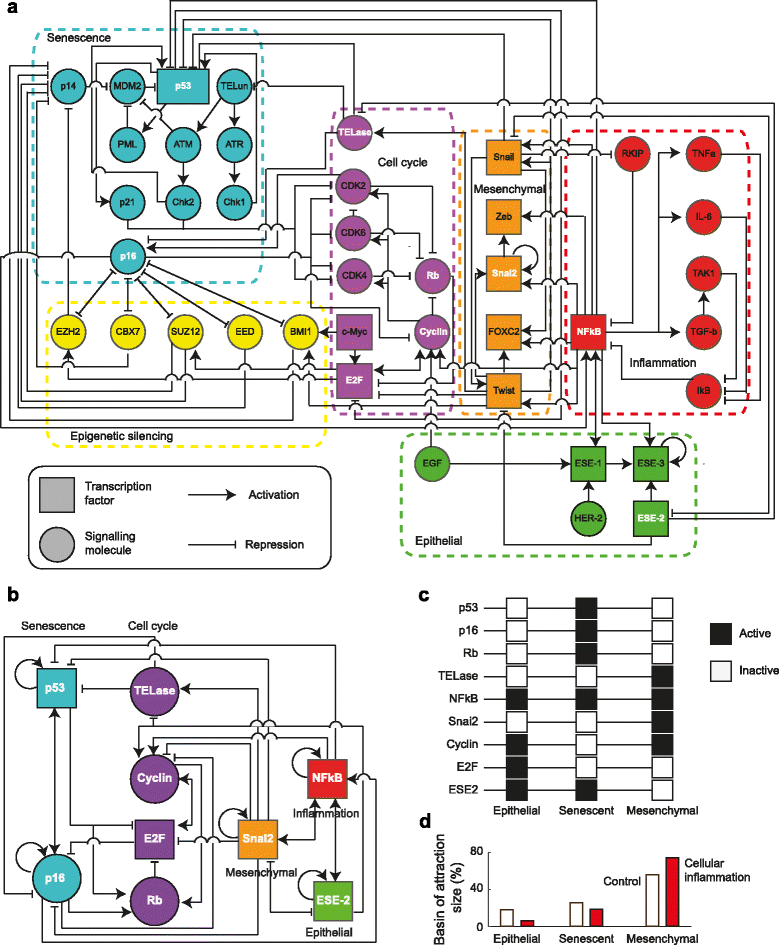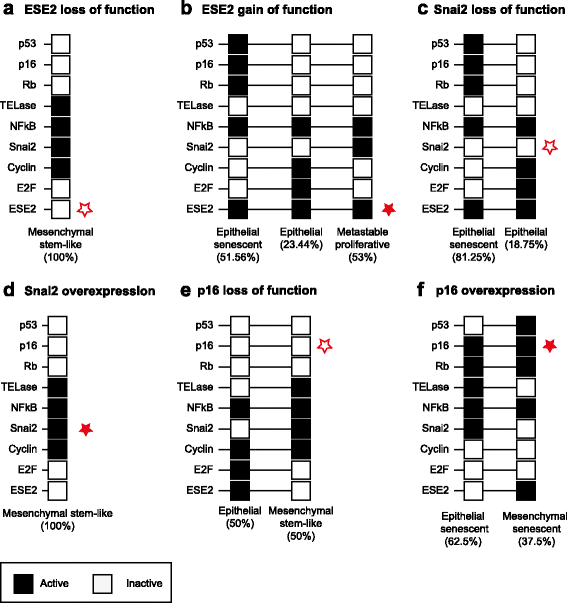Gene regulatory network underlying the immortalization of epithelial cells
- PMID: 28209158
- PMCID: PMC5314717
- DOI: 10.1186/s12918-017-0393-5
Gene regulatory network underlying the immortalization of epithelial cells
Abstract
Background: Tumorigenic transformation of human epithelial cells in vitro has been described experimentally as the potential result of spontaneous immortalization. This process is characterized by a series of cell-state transitions, in which normal epithelial cells acquire first a senescent state which is later surpassed to attain a mesenchymal stem-like phenotype with a potentially tumorigenic behavior. In this paper we aim to provide a system-level mechanistic explanation to the emergence of these cell types, and to the time-ordered transition patterns that are common to neoplasias of epithelial origin. To this end, we first integrate published functional and well-curated molecular data of the components and interactions that have been found to be involved in such cell states and transitions into a network of 41 molecular components. We then reduce this initial network by removing simple mediators (i.e., linear pathways), and formalize the resulting regulatory core into logical rules that govern the dynamics of each of the network components as a function of the states of its regulators.
Results: Computational dynamic analysis shows that our proposed Gene Regulatory Network model recovers exactly three attractors, each of them defined by a specific gene expression profile that corresponds to the epithelial, senescent, and mesenchymal stem-like cellular phenotypes, respectively. We show that although a mesenchymal stem-like state can be attained even under unperturbed physiological conditions, the likelihood of converging to this state is increased when pro-inflammatory conditions are simulated, providing a systems-level mechanistic explanation for the carcinogenic role of chronic inflammatory conditions observed in the clinic. We also found that the regulatory core yields an epigenetic landscape that restricts temporal patterns of progression between the steady states, such that recovered patterns resemble the time-ordered transitions observed during the spontaneous immortalization of epithelial cells, both in vivo and in vitro.
Conclusion: Our study strongly suggests that the in vitro tumorigenic transformation of epithelial cells, which strongly correlates with the patterns observed during the pathological progression of epithelial carcinogenesis in vivo, emerges from underlying regulatory networks involved in epithelial trans-differentiation during development.
Keywords: Boolean models; Carcinomas; Epigenetic landscape; Gene regulatory networks; Phenotypic attractors.
Figures



Similar articles
-
A Boolean model explains phenotypic plasticity changes underlying hepatic cancer stem cells emergence.NPJ Syst Biol Appl. 2024 Sep 2;10(1):99. doi: 10.1038/s41540-024-00422-9. NPJ Syst Biol Appl. 2024. PMID: 39223160 Free PMC article.
-
Floral morphogenesis: stochastic explorations of a gene network epigenetic landscape.PLoS One. 2008;3(11):e3626. doi: 10.1371/journal.pone.0003626. Epub 2008 Nov 3. PLoS One. 2008. PMID: 18978941 Free PMC article.
-
Proteome profiling of immortalization-to-senescence transition of human breast epithelial cells identified MAP2K3 as a senescence-promoting protein which is downregulated in human breast cancer.Proteomics Clin Appl. 2010 Nov;4(10-11):816-28. doi: 10.1002/prca.201000006. Proteomics Clin Appl. 2010. PMID: 21137025
-
Epigenetic Regulation of Inflammatory Cytokine-Induced Epithelial-To-Mesenchymal Cell Transition and Cancer Stem Cell Generation.Cells. 2019 Sep 25;8(10):1143. doi: 10.3390/cells8101143. Cells. 2019. PMID: 31557902 Free PMC article. Review.
-
Design principles of regulatory networks underlying epithelial mesenchymal plasticity in cancer cells.Curr Opin Cell Biol. 2025 Feb;92:102445. doi: 10.1016/j.ceb.2024.102445. Epub 2024 Nov 27. Curr Opin Cell Biol. 2025. PMID: 39608060 Review.
Cited by
-
Capturing dynamic relevance in Boolean networks using graph theoretical measures.Bioinformatics. 2021 Oct 25;37(20):3530-3537. doi: 10.1093/bioinformatics/btab277. Bioinformatics. 2021. PMID: 33983406 Free PMC article.
-
Low dimensionality of phenotypic space as an emergent property of coordinated teams in biological regulatory networks.iScience. 2025 Jan 2;28(2):111730. doi: 10.1016/j.isci.2024.111730. eCollection 2025 Feb 21. iScience. 2025. PMID: 39898023 Free PMC article.
-
Revisiting Epithelial Carcinogenesis.Int J Mol Sci. 2022 Jul 4;23(13):7437. doi: 10.3390/ijms23137437. Int J Mol Sci. 2022. PMID: 35806442 Free PMC article.
-
In Silico Logical Modelling to Uncover Cooperative Interactions in Cancer.Int J Mol Sci. 2021 May 5;22(9):4897. doi: 10.3390/ijms22094897. Int J Mol Sci. 2021. PMID: 34063110 Free PMC article. Review.
-
Landscape and kinetic path quantify critical transitions in epithelial-mesenchymal transition.Biophys J. 2021 Oct 19;120(20):4484-4500. doi: 10.1016/j.bpj.2021.08.043. Epub 2021 Sep 2. Biophys J. 2021. PMID: 34480928 Free PMC article.
References
-
- Huang S. On the intrinsic inevitability of cancer: from foetal to fatal attraction. In: Seminars in cancer biology. vol. 21, No. 3. Academic Press: 2011. p. 183–99. - PubMed
MeSH terms
LinkOut - more resources
Full Text Sources
Other Literature Sources

